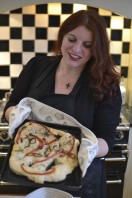The type of cooker you choose for your home is likely to be dependent on a whole host of factors and preferences.
We have come a long way since man huddled over fire. There are now smart cookers that can be turned on from an app on your phone on the way home from work and, apparently, oven’s that can predict the weight and calorific content of your food.
Some people prefer looks to “intelligence” and are swayed almost entirely by the aesthetics of a cooker. They ask: is it in keeping with the “look” I’ve worked hard to achieve throughout the rest of the kitchen? Others – and these are often the designated chefs in the family – are more concerned with functionality, and will want to know how, for example, can this device make the Sunday roast that bit easier to cook.
Whatever your priorities you will have to consider space. Both in terms of where the cooker will best fit in the kitchen and the optimum size for your needs.

Vanessa Kimbell prefers a gas hob and an electric oven
Vanessa Kimbell of Juniper & Rose kitchen garden school in Northamptonshire has this advice: “Firstly ask yourself what kind of things you cook, how often you cook and for how many. Is it important to have a large oven (for deep pans and the Christmas turkey plus trimmings) or perhaps two smaller ovens would be more practical and economical.”
Functionality is key, too, for Alexis Thompson, who runs Dancing Trousers Cookery School in the Cotswolds. As well as asking the retailer about consistency of heating, pre-heating time, ease of cleaning, build quality and noise, she suggests checking out how smooth the action is on the doors: “You don’t want to be fighting an oven door when you’re trying to pull out a boiling hot bain marie full of souffles! If money was no object I would always have an eye-level oven rather than floor level.”
The decision between gas and electric is another particularly important one. Manufacturers like Belling are a good example of how far the technology of electric cookers has come. It used to be the case that those who were able to use a gas hob would do so, as it gives you instant control over the temperature. Today electric hobs are able to adjust their temperature much more effectively and can be easier to keep clean, but gas remains the cheaper fuel.
“I’m a gas lover but I know that induction and electric hobs are fantastically efficient these days,” says Thompson. However, she prefers an electric fan oven for heat distribution and because gas can affect the colour of some baked items. “If you cook meringues in a gas oven they always turn pale brown but in an electric non-fan oven you can keep them snow white!”
And don’t forget a ventilation hood. This helps to extract the vapours from your food as it is cooked and thus prevent a build-up of grease, which ruins your newly installed kitchen.
In terms of buying tips, do your research online and visit a showroom if necessary. Check out a good homes/kitchen magazine, and buy from a reputable retailer to help with fitting and troubleshooting.
“We all have an oven so ask around,” advises Kimbell. “Twitter and Facebook are great places to ask for recommendations as is your local oven repair man – he’s seen the very worst.”
The final consideration for Kimbell is where it is made: “If I can buy British I will. It just feels right to cook my locally sourced meat in with my home grown vegetables in a British-made oven.”
